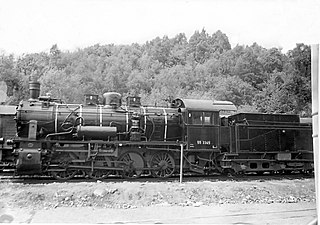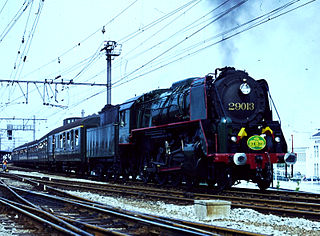
The Deutsche Reichsbahn's Class 52 is a German steam locomotive built in large numbers during the Second World War. It was the most produced type of the so-called Kriegslokomotiven or Kriegsloks. The Class 52 was a wartime development of the pre-war DRG Class 50, using fewer parts and less expensive materials to speed production. They were designed by Richard Wagner who was Chief Engineer of the Central Design Office at the Locomotive Standards Bureau of the DRG. About a dozen classes of locomotive were referred to as Kriegslokomotiven; however, the three main classes were the Class 52, 50 and 42. They were numbered 52 1-52 7794. A total of 20 are preserved in Germany.

The Prussian Class P 8 of the Prussian state railways was a 4-6-0 steam locomotive built from 1906 to 1923 by the Berliner Maschinenbau and twelve other German factories. The design was created by Robert Garbe. It was intended as a successor to the Prussian P 6, which was regarded as unsatisfactory.

The goods train locomotives of Class C VI were German steam engines built between 1899 and 1905 for the Royal Bavarian State Railways. It had great similarity to the Prussian G 5.4, but had a higher boiler overpressure and better riding qualities. In all the Bavarian state railways procured 83 engines of this type over that period. More machines with slight modifications were acquired between 1907 and 1909. These 37 engines were given the designation G 3/4 N. The Deutsche Reichsbahn inherited 64 Class C VI and 32 Class G 3/4 N engines. These were given operating numbers 54 1301–1364 and 54 1401–1432. The Class C VII locomotives remained in service until 1931, their Class G 3/4 N sister locomotives until 1935.

The Prussian G 8.1 was steam locomotive operated by the Prussian state railways. It was a heavier, stronger development of the G 8 and was initially referred to as a 'strengthened standard class'.

Between 1934 and 1941 the Deutsche Reichsbahn (DRG) converted a total of 691 former Prussian-built Class 55.25–56 steam locomotives; the result was the DRG Class 56.2–8. The carrying axle enabled higher speeds and the engine could even be used as a passenger train locomotive. In addition the average axle load was lower, so that these locomotives could also be used on branch lines. The conversion entailed moving the boiler forward and raising it somewhat. The vehicles were given operating numbers between 56 201 and 56 891, although the numbering was not continuous.
The Oldenburg G 4.2 steam locomotives were goods train engines built for the Grand Duchy of Oldenburg State Railways between 1895 and 1909 in several series.
The Prussian G 12.1 was a German steam locomotive built for the Prussian state railways during the First World War and was the largest Prussian freight locomotive with a 2-10-0 wheel arrangement. It had three cylinders, the two outer ones driving the third axle and the inner one the second axle.
The Prussian Class G 5.1 steam engines were the first 2-6-0 goods locomotives in Europe. They were developed for the Prussian state railways from the Class G 4 and a total of no less than 264 units of this class were placed in service in Prussia between 1892 and 1902. The twin-cylinder G 5.1 had been designed to raise the speed of goods trains on main lines. In addition, more powerful engines were needed for the increasingly heavy train loads. The locomotives, which were equipped with a compressed air brake, were used in charge of fast goods trains (Eilgüterzugdienst) and also passenger trains due to their impressive top speed of 65 km/h. The G 5.1 was fitted with inside Allan valve gear and the carrying wheels were of the Adams axle design. The engines were coupled with tenders of Class pr 3 T 12. In Prussian service they were renumbered in 1905 into the 4001–4150 range.

The Prussian Class T 12 were early German passenger tank locomotives built for the Prussian state railways in large numbers. These locomotives were superheated variants of the T 11.

The NMBS/SNCB Type 12 was a class of 4-4-2 steam locomotives built in 1938–1939 for the fast lightweight Ostend boat trains operated by the National Railway Company of Belgium.

The NMBS/SNCB Type 1 was a class of 4-6-2 steam locomotives built in 1935 and 1938 for working heavy express passenger trains operated by the National Railway Company of Belgium (NMBS/SNCB).

The Belgian State Railways Type 7, later known as the NMBS/SNCB Type 7, was a class of 4-6-0 compound locomotives built between 1921 and 1924.

The NMBS/SNCB Type 29 was a class of 2-8-0 steam locomotives built between 1945 and 1946. The class was ordered and used to help revive the operations of the National Railway Company of Belgium (NMBS/SNCB) following World War II. The locomotives were built in Canada and the United States, and supplied to Belgium under the auspices of what later became known as the Marshall Plan.

The Belgian State Railways Type 10, later known as the NMBS/SNCB Type 10, was a class of 4-6-2 steam locomotives built between 1910 and 1914.

The Belgian State Railways Type 23, later known as the NMBS/SNCB Type 53, was a class of 0-8-0T steam locomotives built between 1904 and 1927.

The NMBS/SNCB Type 64 was a class of 4-6-0 steam locomotives built as Prussian P 8s for German railways, delivered as war reparations to Belgium at the end of World War I. 168 locomotives of this type were delivered to Belgium, working mostly on light passenger trains operated by the National Railway Company of Belgium (NMBS/SNCB). The final locomotives of this type were withdrawn in 1967, marking the end of steam service in the country.

The NMBS/SNCB Type 36 was a class of 2-10-0 Decapod steam locomotives built from 1909 to 1914 for heavy freight service in Belgium operated by the National Railway Company of Belgium.
The Prussian G 5.2 was a class of two-cylinder compound goods locomotive introduced in 1895. As with many Prussian locomotive design, simple and compound versions of the same type were built – in this case the G 5.2 was the two-cylinder compound version of the simple G 5.1. The compound locomotives were more economical and more powerful than the simple locomotives; they were more suitable for long stretches with few stops. The newly introduced air brakes made it possible to use the G 5.2 on passenger trains, which the Prussian State Railways often did.
The Prussian G 4.3 was a class of 0-6-0 goods locomotive of the Prussian State Railways; they were manufactured between 1903 and 1907 by Union Giesserei in Königsberg. The type was developed with the aim of improving the running characteristics of 6-coupled locomotives. They proved a more capable design than the normal-type, and so had a higher maximum speed of 60 km/h (37 mph). However, they were quickly outclassed by increasing weight of freight trains.














